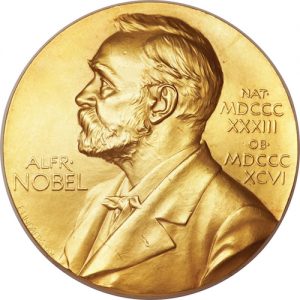The grad students filed into the Physics Building lounge and grabbed a seat on the sofa. It was time for a group meeting with Professor David Thouless.
“He would write an equation on the board,” recalls one of those former students, Sung Rhee, ’03, now a professor of pharmacology and toxicology at the University of Arkansas College of Medicine. “We would all sit and think about it. We were trying to figure out how to solve complex problems. It was very creative work, but very hard work.”
Thouless’ hard work and creativity yielded well-deserved recognition in October, when the 82-year-old professor emeritus, who spent 20 years on the UW faculty, was awarded the 2016 Nobel Prize in Physics along with two other scientists.
Thouless’ mind always seemed to work differently. Fellow UW physics professor John Rehr recalls an anecdote from the 1950s, when Thouless enrolled at Cornell University to work on his doctorate. His adviser? Nobel Laureate Hans Bethe. “Apparently, [Thouless] showed up at Cornell, asked for a thesis topic, and then disappeared for months, finally reappearing with a complete thesis,” Rehr recalls. Usually, students work closely with their adviser to produce their final thesis. It’s no surprise why Bethe is said to have called Thouless his most unusual student.

Michael Schick, UW emeritus professor of physics, recalls how Thouless came to the UW from Yale in 1980. “I met David at a conference back East. He mentioned that he was not happy, so I suggested to my friends in condensed matter physics here at the UW—Greg Dash, Oscar Vilches, Sam Fain, and Eberhard Riedel—that we try to attract him.” At the UW, Thouless often rode his bicycle to work until he retired in 2003, and he and his wife attended neighborhood potlucks in Hawthorne Hills. Thouless also enjoyed bird watching with the UW Retirement Association group, which travels the state stalking the white-tailed ptarmigan or the ruffled grouse.
Thouless, a native of Scotland, took his family traveling in Europe quite often. But they never stayed in hotels, son Michael recalls, because his parents bought a Bedford Dormobile, a 1960s-vintage camper van. Fortunately, when the entire family travels to Stockholm in December for the Nobel Prize ceremony, they won’t be traveling by Dormobile. Son Christopher and his family will fly in from Kenya, where he works on conservation measures. Daughter Helen, who lives in London, will be on hand, too, to cheer on their dad.
Thouless’ Discovery Explained
The Royal Swedish Academy of Sciences honored Thouless for his work exploring exotic states of matter. At the University of Birmingham in England, where he was a professor of mathematical physics from 1965 to 1978, Thouless began a collaboration with J. Michael Kosterlitz, one of the physicists with whom Thouless shares the award. They overturned prevailing theories on how matter behaves in flat, two-dimensional environments. As the Nobel announcement explained, they and F. Duncan Haldane of Princeton University, the third Nobel Laureate, discovered that, in these extreme “flatland” settings matter exhibits properties explained only using complex topological methods.
Topology is the branch of mathematics dealing with properties that change in a stepwise fashion. And it turns out that the promise of new materials and methods for manipulating matter lies within these “flatlands,” where quantum mechanics is exposed and matter assumes more “exotic” states than the typical solid, liquid or gas. Their theories and practices have revealed new ways to understand the physical interactions in this “exotic” state.
“It is the foundation for new technologies we are exploring today, using 2-D surfaces, using grapheme and other new materials,” says Marcel den Nijis, a UW professor of physics who has known Thouless for 35 years. “This award was a long time coming. He’s a brilliant scientist and a wonderful person.”